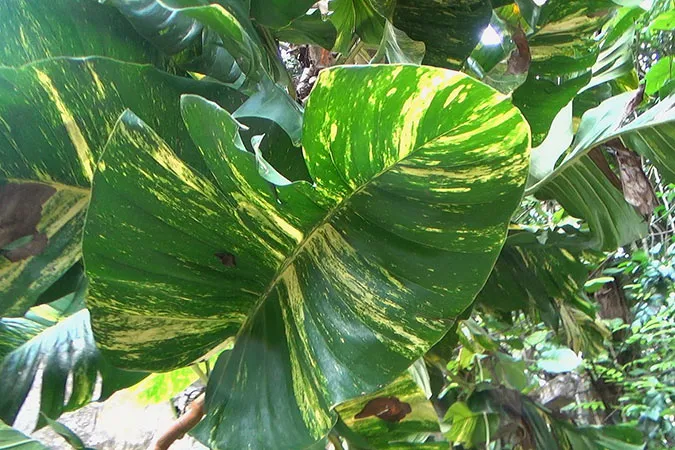Sirih gading or golden pothos (Epipremnum aureum) is a species of plant in Araceae, semi-epiphytic, green leaf striped, bright yellow to pale yellow, grows vines on tree trunks with large leaves and covers the host tree and cut branches can survive a long time if the base is immersed in water.
E. aureum grows vines to a height of up to 20 m, stems up to 4 cm in diameter and aerial roots attached to the surface of the host tree. Stems hang down when climbing trees and will elongate roots when they reach ground level and grow onward.
Leaves sit alternately, heart-shaped, intact on young plants but irregular pinnate on adult plants, reaching 100 cm long, 45 cm wide and 20 cm long young leaves. Leaves that grow on dangling stems are usually 10 cm long and are usually cultivated as potted plants.
Golden pothos are very popular as a houseplant with many cultivars for their white, yellow and light green leaves. Often used in decorative displays in shopping malls, offices, other public locations because it is shady, beautiful and doesn't require much maintenance.
Grows wild in the shade, temperature 17-30C, resistant to dry and poor soil conditions. Sirih gading is able to remove indoor pollutants such as formaldehyde, trichloroethene, toluene, xylene, and benzene.
Kingdom: Plantae
Phylum: Tracheophyta
Subphylum: Angiospermae
Class: Liliopsida
Order: Alismatales
Family: Araceae
Subfamily: Monsteroideae
Genus: Epipremnum
Species: Epipremnum aureum
E. aureum grows vines to a height of up to 20 m, stems up to 4 cm in diameter and aerial roots attached to the surface of the host tree. Stems hang down when climbing trees and will elongate roots when they reach ground level and grow onward.
Leaves sit alternately, heart-shaped, intact on young plants but irregular pinnate on adult plants, reaching 100 cm long, 45 cm wide and 20 cm long young leaves. Leaves that grow on dangling stems are usually 10 cm long and are usually cultivated as potted plants.
Golden pothos are very popular as a houseplant with many cultivars for their white, yellow and light green leaves. Often used in decorative displays in shopping malls, offices, other public locations because it is shady, beautiful and doesn't require much maintenance.
Grows wild in the shade, temperature 17-30C, resistant to dry and poor soil conditions. Sirih gading is able to remove indoor pollutants such as formaldehyde, trichloroethene, toluene, xylene, and benzene.
Kingdom: Plantae
Phylum: Tracheophyta
Subphylum: Angiospermae
Class: Liliopsida
Order: Alismatales
Family: Araceae
Subfamily: Monsteroideae
Genus: Epipremnum
Species: Epipremnum aureum
